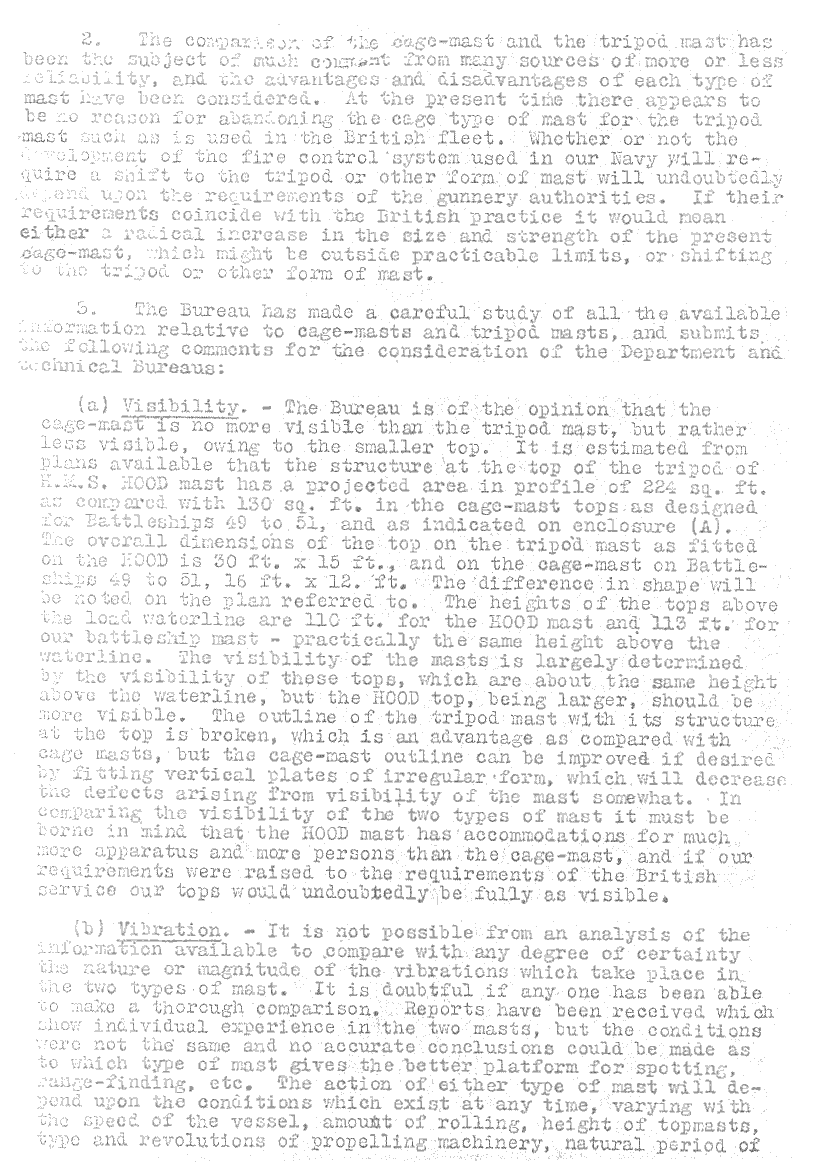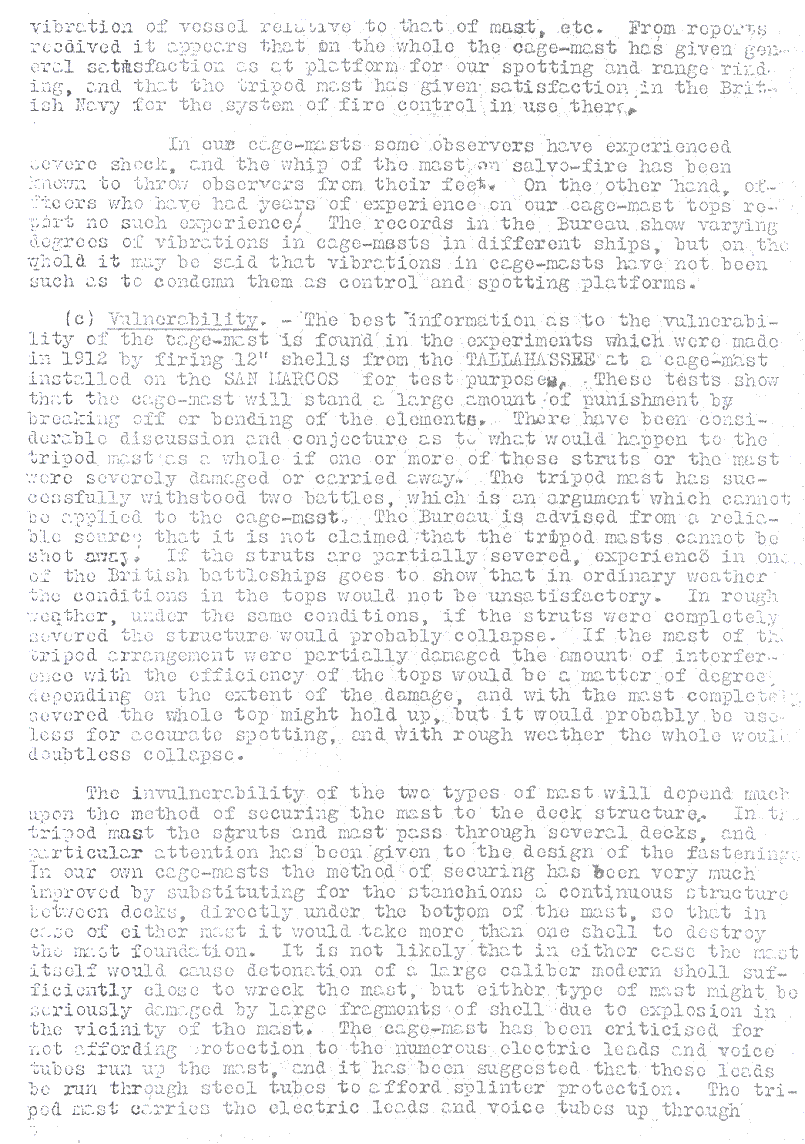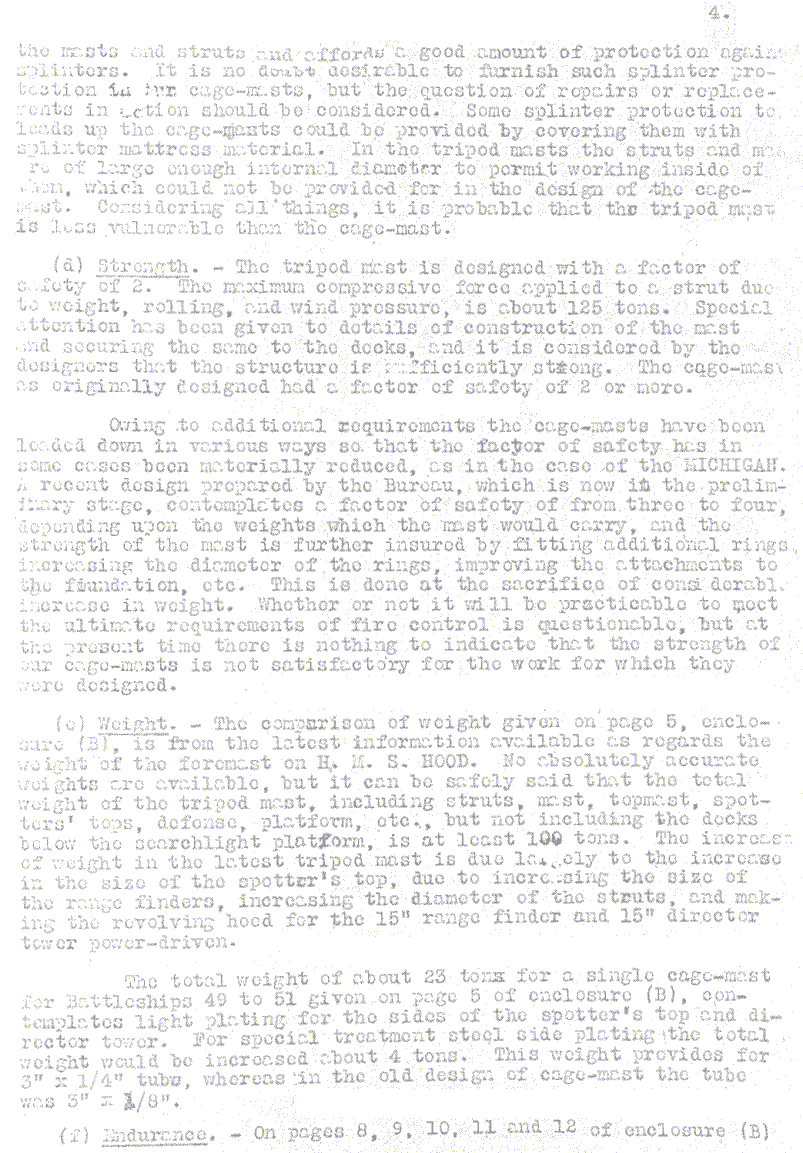




Page 6 is missing

Chuck Moore, of the USS Texas website, has contributed the following memo, dated 25 October 1918. The scans follow the transcription (editorial inserts marked [thusly]). Note that page 6 of the original has not appeared, and thus there is a gap in the text.
| C&R No. | Title | Kind | |
| (A) | O1657 | Comparision of Cage-Masts, Bridges, and Towers, U.S. Battleships and H.M.S. HOOD. | 1 Bp |
| (B). | Comments on Cage-Masts - Research Data. | 1 Copy. |
1. In paragraph 14 of reference (d) it was stated that a comparison of the cage-mast and the tripod mast would be taken in separate correspondence after additional information was received from the other technical Bureaus and other sources of information. The information requested from some of the sources has not as yet been furnished, and until the additional information requested is available it is not practicable to make a final comparison of the two types of masts. However, owing to the considerable lapse of time which has taken place since this report was requested, the Bureau has undertaken a comparison of the two types of masts based on the best information available at this time.
2. The comparison of the cage-mast and the tripod mast has been the subject of much comment from many sources of more or less reliability, and the advantages and disadvantages of each type of mast have been considered. At the present time there appears to be no reason for abandoning the cage type of mast for the tripod mast such as is used in the British fleet. Whether or not the development of the fire control system used in our Navy will require a shift to the tripod or other form of mast will undoubtedly depend upon the requirements of the gunnery authorities. If their requirements coincide with the British practice it would mean either a radical increase in the size and strength of the present cage-mast, which might be outside practicable limits, or shifting to the tripod or other form of mast.
3. The Bureau has made a careful study of all the available information relative to cage-masts and tripod masts, and submits the following comments for the consideration of the Department and technical Bureaus:
(a)Visibility. - The Bureau is of the opinion that the cage-mast is no more visible than the tripod mast, but rather less visible, owing to the smaller top. It is estimated from plans available that the structure at the top of the tripod of H.M.S. HOOD mast has a projected area in profile of 224 sq. ft. as compared with 130 sq. ft. in the cage-mast tops as designed for Battleships 49 to 51, and as indicated on enclosure (A). The overall dimensions of the top on the tripod masst as fitted on the HOOD is 30 ft. x 15 ft., and on the cage-mast on Battleships 49 to 51, 16 ft. x 12. ft. The difference in shape will be noted on the plan referred to. the heights of the tops above the load waterline are 110 ft. for the HOOD mast and 113 ft. for our battleship mast - practically the same height above the waterline. The visibility of the masts is largely determined by the visibility of these tops, which are about the same height above the waterline, but the HOOD top, being larger, should be more visible. The outline of the tripod mast with its structure at the top is broken, which is an advantage as compared with cage masts, but the cage-mast outline can be improved if desired by fitting vertical plates of irregular form, which will decrease the defects arising from visibility of the mast somewhat. In comparing the visibility of the two types of mast it must be borne in mind that the HOOD mast has accomodations for much more apparatus and more persons than the cage-mast, and if our requirements were raised to the requirements of the British service our tops would undoubtedly be fully as visible.
(b)Vibration. - It is not possible from an analysis of the information available to compare with any degree of certainty the nature or magnitude of the vibrations which take place in the two types of mast. It is doubtful if any one has been able to make a thorough comparision. Reports have been received which show individual experience in the two masts, but the conditions were not the same and no accurate conclusions could be made as to which type of mast gives the better platform for spotting, range-finding, etc. The action of either type of mast will depend upon the conditions which exist at any time, varying with the speed of the vessel, amount of rolling, height of topmasts, type and revolutions of propelling machinery, natural period of vibration of vessel relative to that of mast, etc. From reports received it appears that on the whole the cage-mast has given general satisfaction as a platform for our spotting and range finding, and that the tripod mast has given satisfaction in the British Navy for the system of fire control in use there.
In our cage-masts some observers have experienced severe shock, and the whip of the mast on salvo-fire has been known to throw observers from their feet. On the other hand, officers have have had years of experience on our cage-mast tops report no such experience. The records in the Bureau show varying degrees of vibrations in cage-masts in different ships, but on the whole it may be said that vibrations in cage-masts have not been such as to condemn them as control and spotting platforms.
(c)Vulnerability. - The best information as to the vulnerability of the cage-mast is found in the experiments which were made in 1912 by firing 12" shells from the TALLAHASSEE at a cage-mast installed on the SAN MARCOS for test purposes. These test show that the cage-mast will stand a large amount of punishment by breaking off or bening of the elements. There have been considerable discussion and conjecture as to what would happen to the tripod mast as a whole if one or more of these struts or the mast were severely damaged or carried away. The tripod mast has successfully withstood two battles, which is an argument which cannot be applied to the cage-mast. The Bureau is advised froma reliable source that it is not claimed that the tripod masts cannot be shot away. If the struts are partially severed, experience in one of the British battleships goes to show that in ordinary weather the conditions in the tops would not be unsatisfactory. In rough weather, under the same conditions, if the struts were completely severed the structure would probably collapse. If the mast of the tripod arrangement were partially damaged the amount of interference with the efficiency of the tops would be a matter of degree depending on the extent of the damage, and with the mast completely severed the whole top might hold up, but it would probably be useless for accurate spotting, and with rough weather the whole would doubtless collapse.
The invulerability of the two types of mast will depend much upon the method of securing the mast to the deck structure. In the tripod mast the struts and mast pass through several decks, and particular attention has been given to the design of the fastenings. In our own cage-masts the method of securing has been very much improved by substituting for the stanchions a continuous structure between decks, directly under the bottom of the mast, so that in case of either mast it would take more than one shell to destroy the mast foundation. It is not likely that in either case the mast itself would case detonation of a large caliber modern shell sufficiently close to wreck the mast, but either type of mast might be seriously damaged by large fragments of shell due to explosion in the vicinity of the mast. The cage-mast has been criticised for not affording protection to the numerous electric leads and voice tubes run up the mast, and it has been suggested that these leads be run through steel tubes to afford splinter protection. The tripod mast carries the electric leads and voice tubes up through the masts and struts and affords a good amount of protection against splinters. It is no doubt desirable to furnish such splinter protection to our [?] cage-masts, but the question of repairs or replacements in action should be considered. Some splinter protection to leads up the cage-masts could be provided by covering them with splinter mattress material. In the tripod masts the struts and [unknown -- are made?] of large enough internal diameter to permit working inside of them, which could not be provided for in the design of the cage-mast. Considering all things, it is probable that the tripod mast is less vulnerable than the cage-mast.
(d)Strength. - The tripod mast is designed with a factor of safety of 2. The maximum compressive force applied to a strut due to weight, rolling, and wind pressure, is about 125 tons. Special attention has been given to details of construction of the mast and securing the same to the decks, and it is considered by the designers that the structure is sufficiently strong. The cage-mast as originally designed had a factor of safety of 2 or more.
Owing to additional requirements the cage-masts have been loaded down in various ways so that the factor of safety has in some cases been materially reduced, as in the case of the MICHIGAN. A recent design prepared by the Bureau, which is now in the preliminary stage, contemplates a factor of safety of from three to four, depending upon the weights which the mast would carry, and the strength of the mast is further insured by fitting additional rings, increasing the diameter of the rings, improving the attachments to the foundation, etc. This is done at the sacrifice of considerable increase in weight. Whether or not it will be practicable to meet the ultimate requirments of fire control is questionable, but at the present time there is nothing to indicate that the strength of our cage-masts is not satisfactory for the work for which they were designed.
Weight. - The comparison of weight given on page 5, enclosure (B) [not reproduced], is from the latest information available as regards the wieght of the foremast on H.M.S. HOOD. No absolutely accurate weights are available, but it can be safely said that the totoal weight of the tripod mast, including struts, mast, topmast, spotters' tops, defense, platform, etc., but not including the decks below the searchlight platform, os at least 100 tons. The increase in the size of the spotters' top, due to increasing the size of the range finders, increasing the diameter of the struts, and making the revolving hood for the 15" rangefinder and 15" director tower power-driven.
The total weight of about 23 tons for a single cage-mast for Battleships 49 to 51 given on page 5 of enclosure (B) [not reproduced], contemplates light plating for the sides of the spotters' top and director tower. For special treatment steel side plating the total weight would be increased about 4 tons. This weight provides for 3" x 1/4" tube, whereas in the old design of cage-mast the tube was 3" x 1/8".
Endurance. - On pages 8, 9, 10, 11 and 12 of enclosure (B) [not reproduced] will be found extracts from reports on cage-masts which indicate the condition of the cage-masts in service. The reports show that deterioration in the cage-masts has not been serious or unsatisfactory and it is expected that with the knowledge gained by past experiences and reports of detailed inspections made, further precautions can be taken to prevent deteroriation of the parts.
Particular attention is invited to pages 11, 12, 13 and 14 relative to the failure in the case of the MICHIGAN. This failure does not condemn the cage-mast as a design. The latest calculations made indicate that on the MICHIGAN the factor of safety was reduced to practically nothing, and that the mast failed where calculations showed it to be weakest.
It has been pointed out that the cage-mast is a menace in case of collapse. This is true of any type of mast, but it is considered that the damage which would result due to the collapse of the mast would be greatest in the case of the tripod mast, owing to the difference in the design and nature of the structure and the large difference in the wieght of the masts themselves.
(g)Location and Number. - The cage-mast on our battleships and the tripod mast on the British ships have approximately the same relative location with respect to the bridges and conning tower arrangements. A location remote from the bridges and conning towers is not likely. A remote position would be desriable for safety, but the disadvantages outweigh the advantages, and it is asumed that no change in general location is desirable. A single high mast forward is advocated by some, with a short mast aft. This would decrease the visibility of the superstructure of the ship and make it more difficult for the enemy to estimage the course of the vessel. It would have the effect of cutting down the range of the radio telegraph apparatus and would probably result in additional requirments for carrying weight in the foremast.
4. The base of the cage-mast has a diameter of about 20 feet at the superstructure deck height. The base of the mast, being circular in form, takes up more deck space than the tripod mast. A tripod mast would have a spread of about 32 feet between the struts in an athwartship direction, at the superstructure deck, and 15 feet measured on the perpendicular between the upright mast and a line drawn between the struts. In either case the restriction which the mast places on the deck arrangements is not serious, but the deck area required for the cage-mast is greater than for the tripod mast, and the tripod mast permits bridges and deck structures being built around it better than the cage-mast. Several references to the number and location of cage-masts desired will be found in enclosure (B), pages 1, 3, 4, 5 and 6 [not reproduced].
5. In comparing the two types of mast it should be clearly borne in mind that the present cage-masts and the present tripod masts have to meet very different requirements, the requirements in the case of the latter being severe. A striking feature in the general exterior appearance of British battleships and battle cruisers is the amount of structure built up and around the tripod masts. This is required for the housing and protection of the personnel, not only under battle conditions, but particularly for ordinary
aloft. The Bureau has no figures to substantiate this statement.
(f) Endurance. - On account of the design of the cage-mast, involving a large number of relatively small parts in the way of tubes, fittings, rigns, etc., the life of the cage-mast is probably somewhat less than the life of the heavy structures used in the construction of the tripod mast. In either case the life of the mast will depend upon the care and preservation of the materials.
(g) Location and Number. - The number of masts would be the same in either caes, and the same general locations can be selected for either, the available locations of the cage-masts being restricted, however, more than the tripod mast owing to the difference in deck areas required for the base of the mast.
(h) If our fire control requirements and weights carried aloft approach the British practice, it is likely we shall have to adopt the tripod or other mast design.
10. The Bureau recommends that the Bureau of Ordnance include in its comments a comparison of the cage-mast and tripod mast from the point of view of the requirements of director fire, whip on salvo-firing, and motion of the mast when the ship is rolling in a seaway, and the effect of vibration transmitted to the mast through the ship's superstructure.
11. The above enclusires [as written in the original] are for the Department's files. Should any of the Bureaus require copies of the enclosures, some can be obtained from this Bureau.
(SGD) TAYLOR.






Return to WWI The Maritime War
Return to WWI Archive main page.